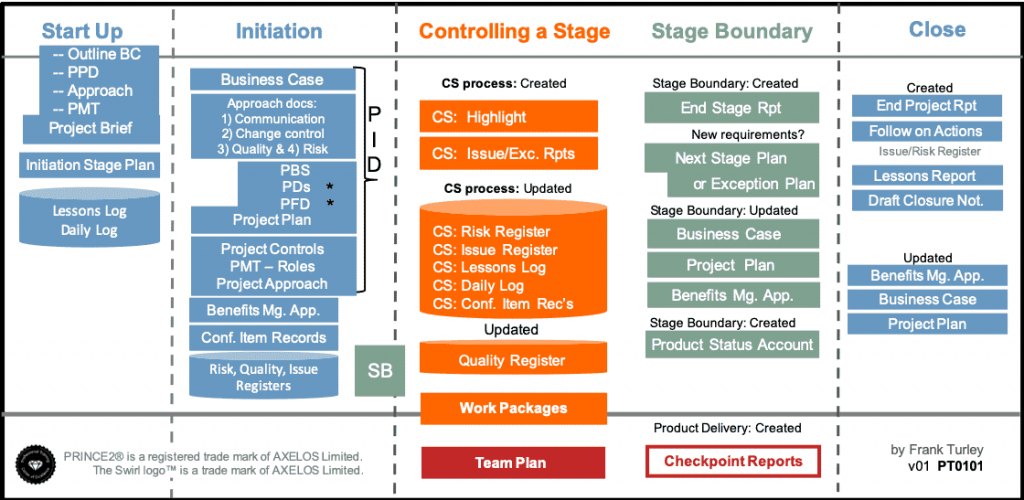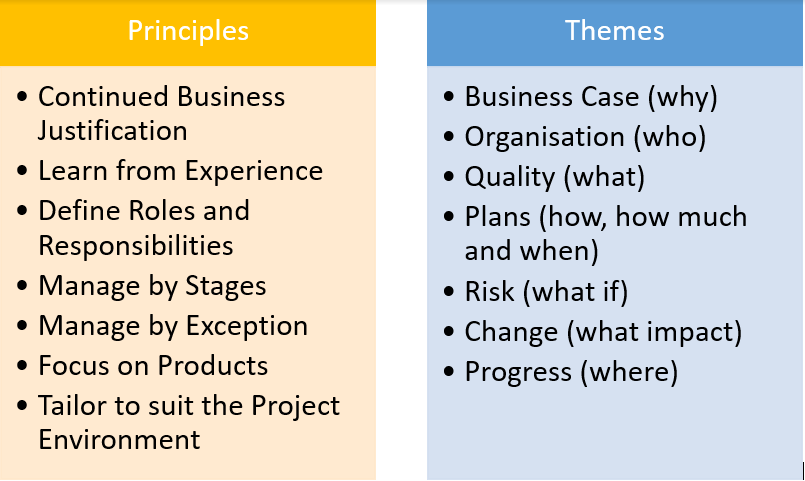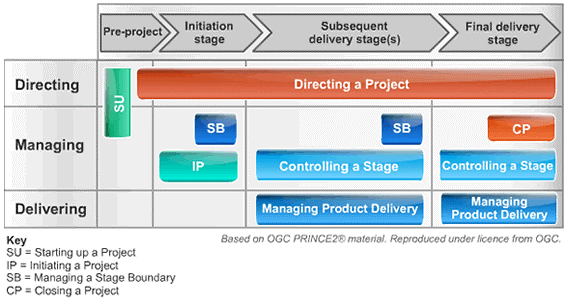Management Products and Processes
This week, learning is broken into two parts:
- A summary of PRINCE2 management products, and an overview of PRINCE2 processes
- Learning activities that will contribute to the development of a Project Management Plan.
There will be more detail on the processes in the weeks to come
Part 1
Management products differ from specialist products. A Specialist product is “a product whose development is the subject of the plan. The specialist products are specific to an individual project (for example, an advertising campaign, a car park ticketing system, foundations for a building, a new business process etc). A specialist product can also be known as a deliverable or output.
Summary of Management Products
PRINCE2 management products are sets of information that come in various forms. They are referred to as “products” rather than documents because they can include presentations, webinars, videos, phone calls, registers, and documents. Management products included in a specific project are determined when the project is tailored to suit the project environment (PRINCE2 Principle). They are incorporated in the processes that produce specialist products and enable the various roles that make up a project management team to communicate, document and implement the project.
Information that is separated into different management products for one project can be merged together or deliberately missed in another. The following list provides an indication of what might be included in a list of management products for a project.
Management products include baselines such as:
- Benefits Management Approach
- Business Case
- Change Control Approach
- Communication Management Approach
- Plan
- Product Description
- Project Brief
- Project Initiation Documentation
- Project Product Description
- Quality Management Approach
- Risk Management Approach
- Work Package
Management products include records such as:
- Daily Log
- Issue Register
- Lessons Log
- Quality Register
- Risk Register
Management products include reports such as:
- Checkpoint Report
- End Project Report
- End Stage Report
- Exception Report
- Highlight Report
- Issue Report
- Lessons Report
Source of list: https://prince2.wiki/management-products/ (retrieved 27/8/2019)
The table below illustrates when management products are developed or updated within the life cycle of a project.

Source: https://prince2.wiki/img/product-map-prince2-simple.png created by Frank Turley
Before Processes – Unit Recap
This unit has mainly focused on PRINCE2 principles and themes so far. They provide a framework for managing projects.

In order to comply with PRINCE2, the seven principles are a must. In other words, the seven principles are the basis of what defines a PRINCE2 project. The seven themes help project managers know, plan and manage the why, who, what, when, where, how and how much of a project. Understanding principles and themes is critical, however running a project is a series of processes and PRINCE2 like most other project methodologies is a process-driven approach. A process is a series of steps/activities, which are made up of recommended actions.
Overview of Processes
There are seven processes in PRINCE2. Two processes aid the governance of projects at a directing level, five aid the organisation and co-ordination of projects at a managing level, one aids the application of techniques that produce outputs at a delivering level. It is worth noting that one process is duplicated across two levels, the directing and managing levels. All seven processes fit within a project’s life cycle, three are likely to be duplicated, potentially repeatedly. The figure below provides a graphic illustration of how the seven processes fit into a matrix, where the project’s life cycle is presented in columns and management levels are presented in rows:

Source: http://apepm.co.uk/shop/prince2-process-model-pdf/
Pre-project
The trigger for a project is called a project mandate and can be a verbal instruction or a written definition of a potential project. Triggers can emerge from organisational strategy when there is a perceived need to target new business opportunities, develop radical improvements in ongoing business processes or it could be to solve problems that can not be achieved through normal business operations. It is worth noting that PRINCE2 is designed for projects in controlled environments, which typically means within existing organisations or infrastructure.
At this stage the question of viability starts to be asked, a project brief and a stage plan is presented to the project board. The level of authority to be delegated to the project manager is established.
Initiating Stage
At this stage planning starts, the business case is formalised, strategies for control are determined and initiating documentation is developed and reviewed by the board. The initiating documentation later becomes the baseline.
Subsequent Delivery Stages
To begin each stage the Project Board delegates authority to the Project Manager, who takes on the responsibility to control stages and manage the product delivery, which involves:
- Assigning work to be done
- Ensuring outputs meet specifications
- Ensure progress is within agreed tolerances
- Monitor forecasts to ensure probable outputs will also be within agreed tolerances
- Gaining approval when required
- Ensuring that project records such registers, logs reports (including checkpoint reports) and configuration item records
Project team members execute assigned work packages and keep the project manager informed.
At the end of each stage project managers provide the project board with information, then request permission to proceed.
Final Deliver Stage
The final delivery stage is the process of closing or decommissioning a project. After a project manager approval for all the completed project products, the project board needs to be satisfied that the new owner of the project’s products is able to use and run the outputs on an ongoing basis, then products can be transitioned to operational use. Closing a project includes conducting reviews to determine the success or otherwise of the project and allocating the timing of reviews that can only be conducted after the products have been used.
PRINCE2’s Process Model
In summary, PRINCE2’s process model looks like the following illustration:

Source: https://www.siliconbeachtraining.co.uk/blog/prince2-process-model
Part 2: Learning Activities Context of Learning Activities
Early in this unit, face-to face students were asked to participate in an activity based on Edward Debono’s six thinking hats. External students were provided a video on the six thinking hats and details of the activity, then encouraged to perform the activity individually. All students should be aware that brainstorming technique can be used to encourage small groups to bounce ideas off each other to creatively identify problems and develop solutions that can then be formed into projects. Brainstorming with a green hat first followed by a black hat, encourages creative ideas and then questions them. The new ideas can become robust and achievable; however, they are not thoroughly considered or developed into something that is measurable. When planning as a group, considered ideas need to be constructed by and then synthesised into one collaborative output.
The build of a project management plan in this unit is designed to be a collaboration that captures considered inputs from all individuals in each component of the plan, exposing students to the benefits and challenges of working in teams.
Assignment 2 is designed to measure the process of developing the project plan as well as the output (final report). Each week from week 6 through to 10 (inclusive) all students are required to submit a contribution to their project plan. Your first submission should have been submitted last week. The work that you submit may not be viewed by the teaching staff, but we will monitor and control (review samples of students’ submissions) in a fashion that is like what a project manager might do when auditing quality. The submissions do not need to be polished and completed pieces of work ready to be slotted directly into the final submission. They are meant to help the leader for that specific week with their submission.
Phase 1 and 2
In week 6 you should have completed phase 1. Phase 1 includes:
- A product description of your proposed project
- An explanation of how and why your group chose this project. It is suggested that you use a comparative weighted selection method.
- Describe the benefits in terms of alignment to strategic intent of a parent organisation.
- Describe the organisational structure of the project and explain how it is to be managed
- Describe the customer supplier environment
- Describe the proposed communication strategy
- Describe the methods that you will be using to:
- Estimate costs
- Estimate time
In week 7 you are to complete phase 2. Phase 2 includes:
- Describe your project plan and your first stage plan, and explain the difference between the two levels
Note: The description of your plans is expected to be detailed (refer to Assignment 2.3 for specifics).
Media Attributions
- Process Model
- principles and themes
- Process Model 2
- Process Model 3
